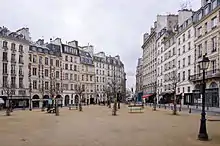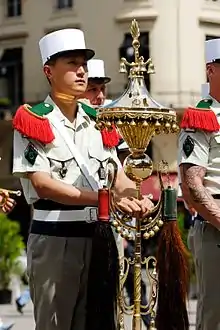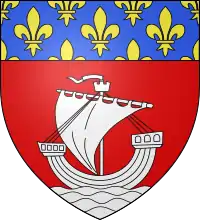Squares in Paris
Paris is known as the City of Light. Part of the credit for this sobriquet can be ascribed to long-standing city ordinances that have restricted the height of buildings in the central city. A more modest skyline, interrupted only by the Eiffel Tower, the Tour Montparnasse, Sacré-Coeur, and a few church steeples, lends this city's citizens virtually unfettered access to natural light. Nonetheless, another significant contributor to the feeling of openness in Paris is the vast number of public spaces, both green and paved, interspersed throughout all twenty arrondissements, that afford the citizen the opportunity to escape, if only momentarily, his urban environment and partake of air and light like his cousins in the provinces. The following article (and its accompanying list) concern the public spaces known as squares and places in Paris.

The word "square"
In Paris (and, more generally, in France), the English word, "square", has been borrowed to describe a particular type of public space. Specifically, a Parisian "square" is a small urban green space that is not large enough to be called a parc (the grassy variety) or a bois (the wooded variety), and it is not sufficiently formal in its plantings to be called a jardin. In the English-speaking world, a Parisian "square" might be called a vest-pocket park or, simply, a "green" (as in "the village green").
However, the French use of the word, "square", presents some small problems in interpretation because native speakers of English use the same word to mean a notable urban crossroads (like Times Square in New York City) or an urban roundabout (like Trafalgar Square in London), where neither grass nor trees nor flowers are present. Such a public space would be called a place in Paris: as in Place de l'Étoile or Place des Vosges or Place de Clichy. The French use of the word "place", —— where, in the USA, the UK, Canada, etc., an English-speaker would use the word "square", —— follows the pattern established in other European languages: the Spanish use the cognate, "plaza" (like Madrid's Plaza Mayor); the Germans use "platz" (Berlin's Potsdamer Platz); the Italians use "piazza" (Rome's Piazza Navona); etc.
So, in summary, the French have "squares" that might (or, more likely, might not) be called "squares" in English, and they use the word "place" to denote what an anglophone would almost certainly call a "square".
Squares and places
To make things a bit more complicated, in Paris, a "square" (small green space) may abut a place (large public square), or a "square" may, in fact, be contained within a place. The "square" and the associated place typically have different names. Some examples are:

within the square of the same name
facing the Place Franz Liszt
- Square des Innocents and Place Joachim du Bellay
- Square Marcel Pagnol and Place Henri Bergson
- Square des Batignolles and Place Charles Fillion
- Square Berlioz and Place Adolphe Max
- Square de la Trinité and Place d'Estienne-d'Orves
- Square Saint-Vincent-de-Paul and Place Franz Liszt
- Square Monseigneur Maillet and Place des Fêtes
- Square Thomas Jefferson and Place des États-Unis
Rarely, the "square" and its associated place share a name:
- Square Ferdinand Brunot and Place Ferdinand Brunot
- Square de la Chapelle and Place de la Chapelle

Finally, there are some pairs (of squares and places) where the name of the square is a bit artificial, but the relationship is, nonetheless, clear:
- Square de la place André-Masson
- Square de la place Dauphine
- Square de la place de Bitche
- Square de la place de la Bataille de Stalingrad
- Square de la place de la Nation
- Square de la place de la Réunion
- Square de la place d'Italie
- Square de la place du Commerce
- Square de la place Étienne Pernet
- Square de la place Pasdeloup
Characteristics of Parisian squares
In all Parisian squares, gardens, and parks, you will find areas reserved for children, with playgrounds, sandboxes, see-saws, swings, merry-go-rounds, and the like. Some spaces offer a wider range of activities; some random examples are: toy boats to sail, as well as sulky and go-cart rentals in the Jardin du Luxembourg; ping-pong tables in the Square Emile-Chautemps and the Jardin de l'Observatoire; pony or carriage rides at the Parc Monceau; tennis courts, boules, and croquet at the Jardin du Luxembourg; Guignol marionette puppet shows at the Jardin du Ranelagh; roller skating at the Parc Montsouris; a bee-keeping school at the Jardin du Luxembourg; bandstands featuring spring and summer concerts at the Square du Temple and the Parc des Buttes-Chaumont, etc.
These open spaces also beckon visitors just to wander and daydream, and many offer lush green lawns for sitting, taking a rest, or perhaps a picnic. One is advised, nonetheless, to watch for signs posted on lawns that are accessible to the public: pelouses autorisées (lawns authorized for use) and "pelouses au repos" (lawns for resting).

List of squares and places in Paris
As of 1 May 2008, the city of Paris acknowledged the following public squares (in the broader 'English' sense of the word). A citizen of Paris will notice, of course, that the following alphabetized list includes both "squares" (smaller green spaces) and places (larger urban landmarks), which have been segregated from one another within this single list.
0/9
- Place du 11-Novembre-1918
- Place du 18-Juin-1940
- Place du 25-Août-1944
- Place du 8 Février 1962
- Place du 8 Novembre 1942
A
|
|
|

B
|
|
|
C
|
|
|
D

|
|
|
E

|
|
F

|
|
G
|
|
|
H

at the Place de l'Hôtel-de-Ville,
7 April 2008
|
|
I
|
|
J
|
|
|
K
|
L

|
|
M
|
|
|

N
|
|
O
|
|
P
|
|
|
Q
|
|
R

|
|
S

from the Place de Saint-Augustin
|
|
|
T
|
|
U
|
|
V

(Note the sign on the lawn)
|
|
|
W
|
Y
|
|
External links
| Wikimedia Commons has media related to Squares in Paris. |
